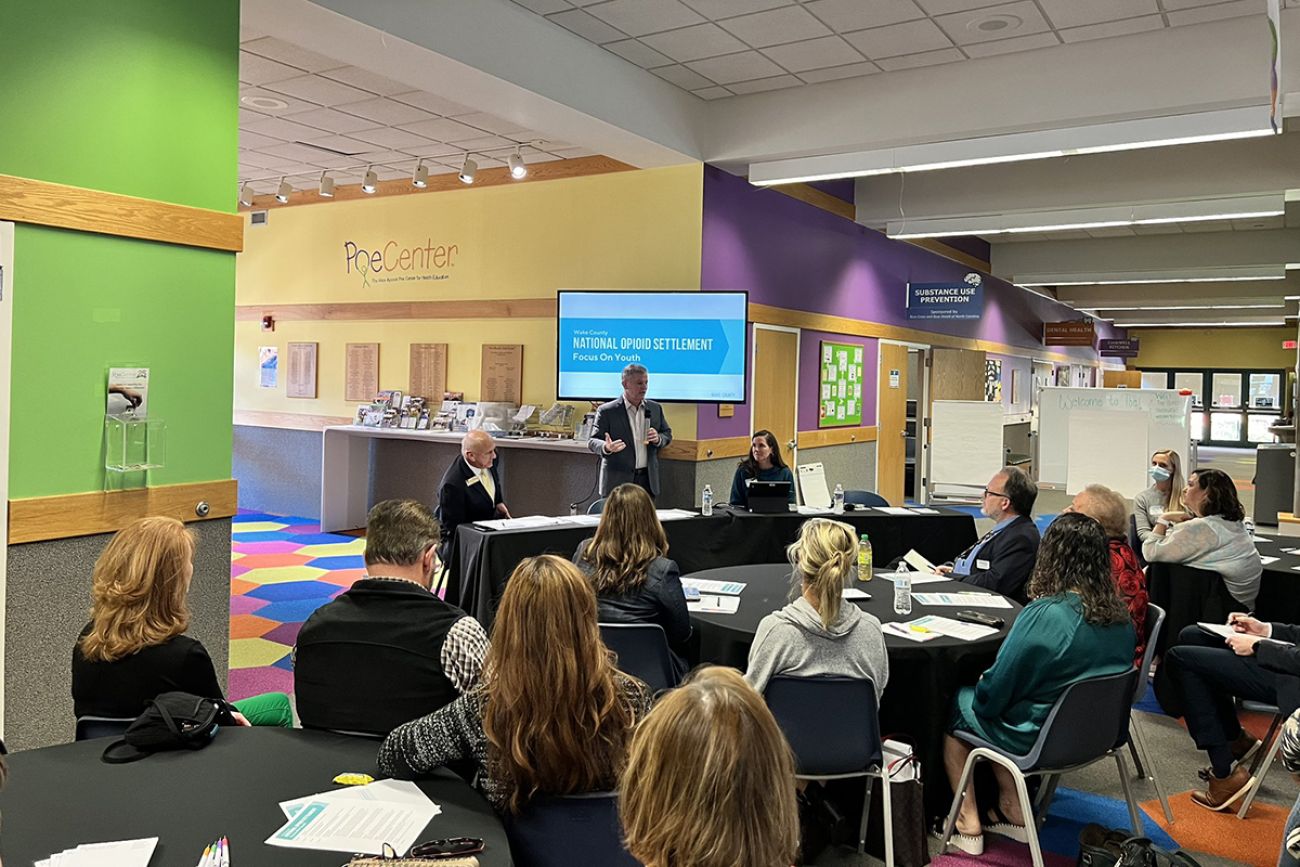Michigan won’t know how $725M is spent on opioids help. Other states do it better

- Michigan is less transparent and has less centralized control than other states on how opioid settlement funds are used
- North Carolina requires local jurisdictions to file annual financial and impact reports on spending
- Colorado has state and regional oversight of spending to avoid redundancies
In rural west North Carolina, Alexander County is setting aside $212,000 from opioid lawsuit settlement funds to hire a paramedic to focus on overdoses and follow-ups.
A hundred miles east, Asheville is expanding access to medication-assisted treatment for those addicted to opioids, at a cost of $90,000.
And in the foothills of the Blue Ridge Mountains, Caldwell County is buying $25,000 worth of Narcan, used to revive people who’ve overdosed on opioids and have stopped breathing.
About these stories
Michigan is set to receive $1.5 billion from a national settlement with opioids manufacturers and distributors. Bridge Michigan interviewed more than four dozen experts, community leaders and researchers. Many expressed worries that Michigan has not set up enough oversight of how the money is being spent.
As opioid deaths mount, Michigan governments sit on millions for intervention
See how much your Michigan community will get in opioid settlement funds
Michigan opioid cash sparks feeding frenzy of vendors, seeking cut of $1.5B
Michigan county ‘hit ground running’ with opioid plan. Then came the complaints
Has the opioid crisis hit your family? We seek Michigan stories
Bridge Lunch Break
On Feb. 28, Bridge reporters and experts will discuss the drug crisis and how Michigan governments are spending the $1.5 billion coming the state’s way. Learn how to sign up here.
Get help
For help with opioid abuse, call the SAMSHA National Hotline, a 24-hour, 365-day-a-year, treatment referral hotline. 1-800-662-HELP (4357)
That’s the kind of specific information on how North Carolina’s settlement funds are being spent that is available on a website run by the state.
It’s also the type of information that Michigan residents are unlikely to ever see.
Michigan ranks near the bottom of the nation in transparency and accountability over opioid settlement funds, which makes it more difficult to guard against inappropriate or inefficient spending of the $1.5 billion the state will receive over 18 years.
Just 10 states currently plan to publicly report less about how they spend their share of opioid settlement funds than Michigan’s plan of 50%. Twenty states, plan to publicly account for 100% of spending.
“The transparency is abysmal,” said Jonathan Stoltman, director of the Michigan-based Opioid Policy Institute, a national research think tank based in Grand Rapids.
Forty-six states are sharing about $50 billion as part of a national settlement of numerous lawsuits against manufacturers, distributors and pharmacies accused of downplaying the risks and ignoring the perils of prescription painkillers, fueling a nationwide opioid crisis.
Individual states have broad latitude to set their own rules for how funds are distributed, as well as reporting requirements.
In Michigan, a little more than 50% of funds will go to the state government. Michigan has vowed to publicly disclose how those funds are spent. The rest goes to counties, townships and cities, which, by the terms of an agreement reached with the state, don’t have to disclose how they spend the $725 million they are set to receive over 18 years.
Related:
- Michigan disbands racial equity group as tension mounts over opioid money
- In Michigan, naloxone has reversed over 6,600 overdoses since 2020
- Michigan unveils spending on $1.5B opioid settlement, amid secrecy fears
North Carolina took a different approach. There, state officials negotiated an agreement with the state’s 100 counties: local governments would get 85% of all settlement funds flowing into the state. In exchange for the larger share of the pot, counties agreed to exhaustive reporting requirements, annual financial and impact reports and an approval process for spending that flows through the state’s Department of Justice — North Carolina’s version of Michigan’s Attorney General’s office — and the Community Opioid Resource Engine (CORE-NC).
On the state-run settlement online dashboard, North Carolina residents can read the plans for individual counties as well as how money has been spent so far. The state also aggregates the spending by categories such as early intervention and recovery housing.
“As we look at actual spending, there really haven’t been any problems,” Steve Mange, senior policy and legislative counsel in the state’s Department of Justice, told Bridge Michigan.
“If any public health expert looked at where it’s going, they’d be impressed,” Mange said. “These are evidence-based strategies.”
Matthew Walker, an attorney in the Michigan Attorney General’s office who was involved in negotiations between the state and local officials on rules for funding disbursement, told Bridge Michigan in an email that his office has “yet to learn of misappropriated settlement dollars” by local jurisdictions.
But he acknowledged the state does not provide a “central repository” of funding details that would allow state officials to systematically examine spending.
While there are guidelines for how the funds are supposed to be spent (a minimum of 85% for opioid remediation, with at least 70% for efforts going forward), no one is checking to see if that happens, advocates say.
“Michigan didn't set it up right, so there's not a whole lot of accountability,” said Kara Steinke, chief operations officer of Up North Prevention, part of Catholic Human Services, which works in 21 counties in the northern Lower Peninsula.
“If they don't use it the right way, no one's checking. So we're relying on really good people … to do the right thing.”
Colorado is another state that plans to publicly report 100% of its spending. There, 60% of the expected $750 million coming to the state goes to 19 regional opioid abatement councils created to coordinate spending, fill coverage gaps and avoid redundancies from county to county. Another 20% goes to local jurisdictions, but most of them have turned their money over to the regional committees.
Those regional councils report to a statewide opioid abatement council, which holds virtual meetings that the public can attend online.
That contrasts with Michigan, where its 83 counties and nearly 200 townships and cities receiving funds have autonomy over how that money is allocated, as long as at least 85% is used for opioid remediation.
“It’s really obvious the states that started thinking about this some time ago, versus the states that were waiting to get their money before planning,” said Sara Whaley, program director of the Bloomberg Overdose Prevention Initiative at Johns Hopkins Bloomberg School of Public Health.
Walker, of Michigan’s AG office, said creating a centralized reporting system for funding would take manpower and money — money that would likely come from settlement funds and thus cut the amount available for direct treatment.
“There is a conversation to be had about the balance of benefit and burden,” Walker wrote in an email.
Danny Wimmer, press secretary for Michigan Attorney General Dana Nessel, said in an emailed response to questions by Bridge that the office is “comfortable with the reporting requirements enacted by the settlement agreements.”
Wimmer and Walker added, though, that the AG’s office may begin documenting how funds are spent, but did not specify how that would be done.
“We are in the process of developing strategies for enforcement, which may or may not include collecting expenditure data from local governments,” Walker wrote. “I am hopeful that we will never need to take legal action against a local government for their opioid spending.”
See what new members are saying about why they donated to Bridge Michigan:
- “In order for this information to be accurate and unbiased it must be underwritten by its readers, not by special interests.” - Larry S.
- “Not many other media sources report on the topics Bridge does.” - Susan B.
- “Your journalism is outstanding and rare these days.” - Mark S.
If you want to ensure the future of nonpartisan, nonprofit Michigan journalism, please become a member today. You, too, will be asked why you donated and maybe we'll feature your quote next time!








